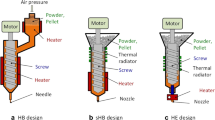Abstract
Nowadays, 3D printing technology is becoming more popular with various applications. 3D printing is also a potential process in tissue engineering applications for fabricating scaffold. The scaffold needs to have the proper structure and properties to initiate a favorable environment for cell growth and tissue generation. In this study, the customized direct powder extrusion based on screw extruder was developed and the influence of printing parameters including printing speed and temperature on characteristics of scaffolds from PCL powder was investigated. The result evaluation shows that the size of line width and pore size are significantly affected by printing parameters. The optimal printing conditions were obtained at print speed 6 mm/s, extrusion speed 50 rpm, and heating temperature of 100 ℃ to fabricate scaffolds from PCL powder materials. The results are the basis for further studies in optimizing the printing condition for PCL scaffolds based on direct powder extrusion.
Access this chapter
Tax calculation will be finalised at checkout
Purchases are for personal use only
Similar content being viewed by others

References
Gleadall, A., et al.: Review of additive manufactured tissue engineering scaffolds: relationship between geometry and performance. Burns Trauma 6, 1–16 (2018)
Jahani, B., Wang, X., Brooks, A.: Additive manufacturing techniques for fabrication of bone scaffolds for tissue engineering applications. Recent Prog. Mater. 2(3), 1–41 (2020)
O’Brien, F.J.: Biomaterials & scaffolds for tissue engineering. Mater. Today 14(3), 88–95 (2011)
Paula, A., et al.: Advances in additive manufacturing for bone tissue engineering scaffolds. Mater. Sci. Eng., C 100, 631–644 (2019)
Acknowledgments
This research is funded by the Vingroup Innovation Foundation (VINIF) through project VINIF.2020.DA13.
Author information
Authors and Affiliations
Corresponding author
Editor information
Editors and Affiliations
Rights and permissions
Copyright information
© 2023 The Author(s), under exclusive license to Springer Nature Switzerland AG
About this paper
Cite this paper
Do, Q.D., Nguyen, D.K., Van Nguyen, T., Phung, L.X., Nguyen, T.K. (2023). Effect of Printing Parameters on Characteristics of PCL Scaffold Fabricated by Direct Powder Extrusion. In: Nguyen, D.C., Vu, N.P., Long, B.T., Puta, H., Sattler, KU. (eds) Advances in Engineering Research and Application. ICERA 2022. Lecture Notes in Networks and Systems, vol 602. Springer, Cham. https://doi.org/10.1007/978-3-031-22200-9_51
Download citation
DOI: https://doi.org/10.1007/978-3-031-22200-9_51
Published:
Publisher Name: Springer, Cham
Print ISBN: 978-3-031-22199-6
Online ISBN: 978-3-031-22200-9
eBook Packages: EngineeringEngineering (R0)



